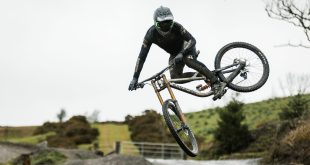London’s Science Museum is displaying UltraBike for cyclists with sight loss, as part of a exhibition highlighting innovations that transform lives.
The ultrasound sensor kit enables people with visual impairments to ride a bicycle independently. The detachable unit can be fitted onto the handlebars of any bike and was designed by electronics engineer Dr Paul Clark.
UltraBike’s sensors give the rider constant directional feedback of obstacles ahead and at each side, via vibrating buttons positioned underneath each thumb. Despite their visual impairment, this technology enables cyclists who are blind or visually impaired to negotiate their way safely and independently along a controlled cycle track.
“The UltraBike is not suitable for visually impaired road cyclists because road drivers assume a cyclist can see, so this is clearly too hazardous," explained Dr Clark. "It is designed for use in a supervised and controlled environment and has great potential for use in sport and velodrome settings in particular. We are now looking at specific enhancements to the technology for this purpose.”
The developers of the UltraBike used the same obstacle detection capability in the award-winning UltraCane, an electronic mobility aid. The UltraCane is a used by people with sight loss all over the world to avoid hazards and injury that can result when using a standard long cane to walk around.
The UltraCane mimics the echolocation abilities of bats and was featured on the BBC documentary series Miracles of Nature, fronted by Richard Hammond in 2012.
The programme makers approached Dr Clark’s company Comms Design, to adapt the UltraCane technology for use on a bicycle that could be tested with a blind rider. Dan Smith, who had been a keen solo cyclist before losing his sight, was shown on the programme steering a straight course through a heavily wooded cycle path on the first UltraBike.
The display at the Science Museum includes an interview with Dr Clark in which he explains how he approached the challenges of turning a ground breaking ‘what if’ idea into an engineering reality.
Since the programme, Sound Foresight Technology has made the kits more widely available, to give groups of visually impaired riders the opportunity to try an UltraBike, most notably at a world first event run by Life Cycle UK in Bristol, on a specially constructed cycle track.
Sound Foresight Technology is currently working with sports organisations around the country to run UltraBike events and is encouraged by the interest shown in the technology by the Royal National Institute for the Blind (RNIB) and the organisers of the Commonwealth Games, due to take place in Glasgow in 2014.
UltraBike is on display in the Science Museum’s Antenna gallery.
 BikeBiz Bicycle and cycling retail news
BikeBiz Bicycle and cycling retail news



